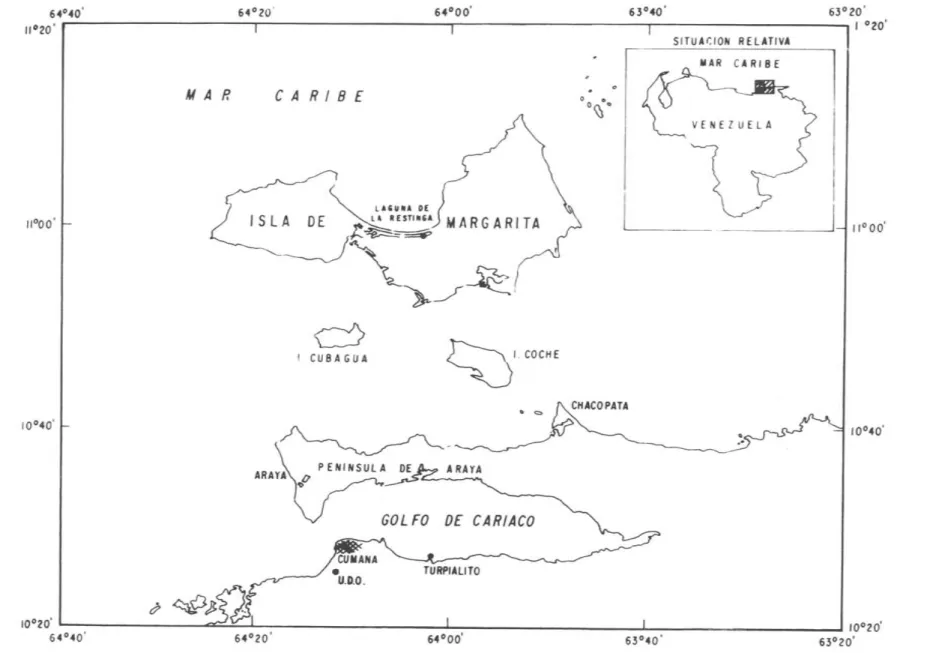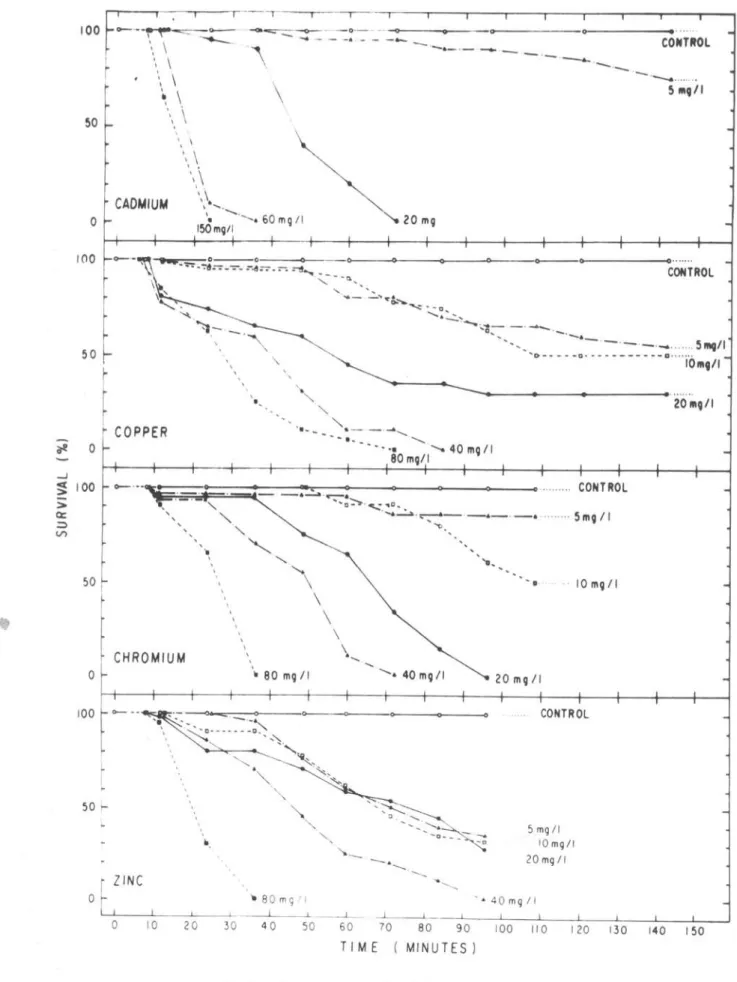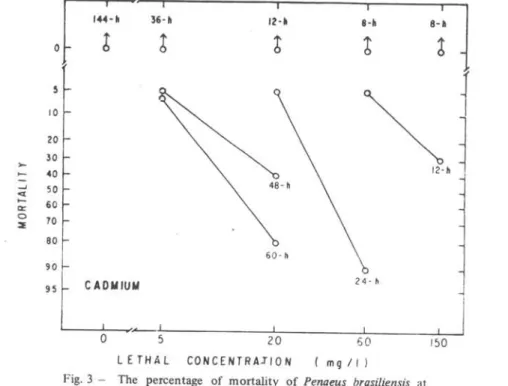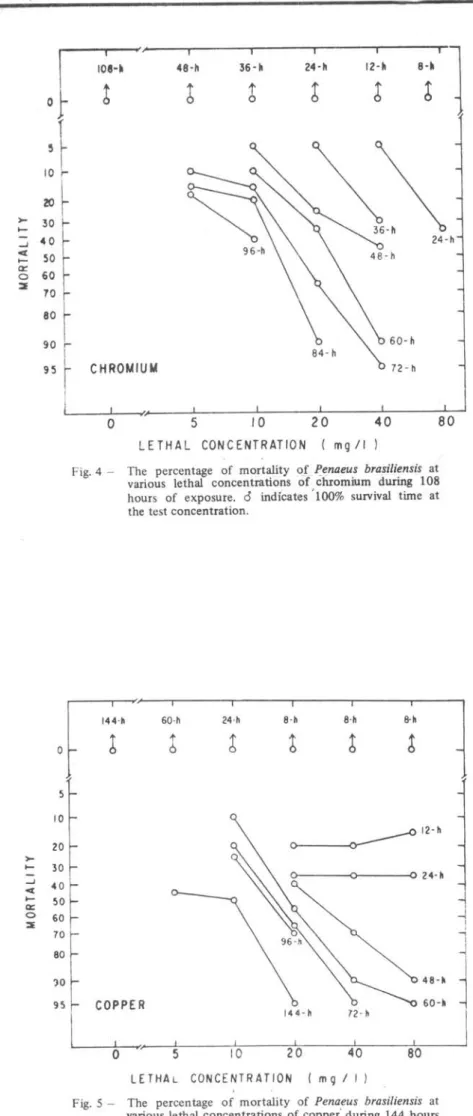Bolmltíst.oooanogr .• S. Paulo.29 (2).101 - 106.1980
%
lHE ACUTE TOXICITY OF FOUR HEAVY METALS (Cd++. Cr+++. Cu++. and Zn++)
TO THE JUVENILE SPOTIED BROWN SHRIMP
(PENAEUS BRASILIENSIS)
K . S. CHUNG
I nstituto Oceanog ráfico, Universidad de Oriente, Cumaná, Venezuela
SYNOPSIS
The atatic biossays were performed to determine lethal concentration (LCso) values of four beaVl' metals/Cd++. cl++· CU++. and Zn ++) of spotted brown shrimp (Penaeus brasiliensis). The test animais were collected from the Laguna of Restinga. Nueva lf'parta. and
we"
acelimated in the /abol'atory eondition for 11-21 days. Temperature and salinity were 22°C and '36 ppt. respectively. The LCso value, (mg/2) d'termirled by probabilit,-Iogarithm transformation were as follow$-cadmium : 38 (24 - h), 21 (48 - h), and 12 (60 - h);ehromium:40 (48 - h). 23 (60 - h). 13 (86 - h), and 10 (96 - h); éopper: 24 (48 - h) , 19 (60 - h), 16 (72 - h). 14 (86 - h). and 10 (144 - h); and zine : 69 (24 - h). 25 (36 - h), 15 (48 - h) and'8 (60 - h). The LCso values of 48 - h and 60 - h indicate that the moat toxic heavy metais to P. brasüiensis in order are zinco cadmium. copper. and chromium.Introduction
Most previous studies concerned with the effects of heavy metais have dealt with fishes and some invertebrates (BaIl. 1967; I3rown • .l9§..8:_Cai,rns _& Scheier, 1958; Eisler. 1971 ; Mount. 1968 ; Negilski.1976; Patrick et ai .• 1968; Pickering & Henderson, 1966; Trama & Benoit. 1960; Wisely & Blick. 1967). lnforrnation on the lethal concentration values of the crustaceans is limited to Portman (1968), Arthur & Leonard (1970). and Eisler (1971).
The pink spotted shrimp (Penaeus brasilienais)
is
one of the most important shrimp fisheries resources in the coastal are as of Venezuela (Ewald, 1967; Khandker, 1965). On the coast of Marga-rita Island, this species is the major shrimp catch resource, and 95% of shrimp collected from 50 m in depth and almost 100% of shrimp from 50-70 m are P. brasiliensis (Khandker & Lares, 1973). The maturity and fecundity of this species was reported by Lares (976). However, the information is limited for the effects of heavy metals in this species.The pUI])ose of this study is to determine "llrvival of P. brasiliensis at four neavy metals, cadmium (Cdcl2 . H20) , chromium (Cr03), copper (CuS04. 5H2 O), and zine (lnS04 ' 7H20). The pink spotted shrimp was seleeted as the test animal because of its abundance in the coastal areas of Venezuela and its eeonomieal and ecological significanee among fisheries resources. This report investigates the effeets of potential heavy metal pollutants, which may be present in domestic wastes in concentrations above ambient, especially near the industrialized are as, on components of marine biota.
Materiais and Methods
The pink spotted shrimp (Penaeus brasiliensis) were colleeted from the Laguna Restinga, Nueva Esparta State, Venezuela (Fig. 1). Average total body length (from the tip of the rostrum to the end of the telson) was 40 mm. Water temperature and salinity were 26 ° C and 52 ppt, respectively. The shrimp were placed in two asbestos tanks (1 - x 1 - x I - m) and transported from Margarita to Cumaná with aeration. During transportation, salinity was adjusted to 36 ppt. About 2,000 shrimp were placed in each asbestos tank and their survival was excellent (almost 100%). The shrimp were held in Turpialito Mariculture Tanks (2 - x 4 - x 1 - m depth) for 15 days and transported from Turpialito to the physiologieal ecology laboratory of the University of Oriente, Cumaná. In the laboratory, animais were placed in aquaria (30 - x 60 - x 40 - em depth) and acclimated for 11 - 21 days.. AccI.iJruWoJ;l temperature
and salinity were 22°C ± 1.5 and 36 ppt, respectively.
lniciarina (Purina Co.) was fed as the rate' of about 5 % of total body wet weight of shrimp every day during acclimation periods. The food was not provided 24 hours prior to the experimento The metais used were cadmiuJl!, chromiurn, copper, and zinco The amounts required to make 10 g/f. stock solution for each metals are: 17.9 g (Cdel2 . H20), 19.2 g (Cr03), 39.3 g (CuS04 . 5H20) ,
and 43.9 g (lnS04 ' 7H20).
The different concentrations used in each bioassay were prepared from the respeetive stock solution as indicated in Table I. The sodiurn citrate was used as a ehelating agent in the copper and zinc experiments.
Twenty animais were placed in 4 replieate flask.s, 16 - x 16 - x 20 - em depth, (5 animals in a flask) at each lethal concen-tration of heavy metal. Four-hundred-eighty (480) shrimps were tested using the four heavy metal toxicants. Food was not supplied . during bioassay experiments. The experiments lasted until 50% or
Table I - Concentration of heavy metals in bioassay experiments (mg/ Q) and hydrological data.
Metal
Cadmium Chromium Copper linc
Concentration (mgl
2)
0,1,5, 20,60, 150 0,5, 10, 20,40, 80O, 5, 10, 20,40. 80 O, 5, 10, 20,40, 80
Temperature (0C)
22.0-22.7 21.5-23.5 21.7 - 22.5 21.3-23.2 Salinity (pPt) 36 36 36 36 pH 7.3-8.4 7.9-8,0 7.7-7.8 7.5-7.7
more of the animals died in the weakest letnal concentration or until the animals in the controlled solution s.tarted. to die.
The mortauty was observed at 30 -min, 1 - h, 2 - h, 4 - h, 8-h, 12-h, 24-h, 36-h, 48-h, 60-h, 72-h, 84-h, 96-h. 120 - h, and 144 - h intervals. The lethal concentration value, LC so (the lethal concentration of 5()% mortality), was determined by straightline graphical interpolation of probability (Yaxis) -logarithm (X-axis) transformation.
Results and Diseussion
The percentages of survival of the pink spotted shrimp (Penaeus brasiliensis) tested at the lethal coneentration offour heavy metais is presented in Figure 2. The lethal coneentration values (LCso) determined by probability logarithm transformation
are summanzed iõ-Tãhle-rC .
Table 11 - Lethal concentration (LC so ) values of four heavy metals to the juvenile pink spotted shrimp (Penaeus brasiliensis,) acclimated at 22°C and 36 PPt.
LCs o value (mgl Q)
Metal
24-h 36-h 48-h 60-h 72-h 84-h 96-h 144-h
Cadrnium 38 21 12
Chromium 40 23 13 10
Copper 24 19 16 14 10
Zinc 69 25 15 8
'.~~.
64040' 64°20 ' 64°00' 63°40 ' 63°20'
11 o 20'
r
I
I
I
I
I ° 20'SITUAl:ION RElATIVA
M A P.
CA R/BE
o DO0\\
VENEZUELA
11°00'
~A
~~'"
DE
~~
":::::'::') M A R G A R I TA
---J~~J~
'----
_._---
~
11°00'
d
1 CUBAGUA
~'
coe",
10°40'
~
-
10°40'ARArA \.
'O"
A RArAGOL FO DE CAR/ACO
TURPIAlITO
d>
10020' , ...ç..!V I I 10020'
64°40 ' 64°20' 64°00' 63°40' 63°20'
figo I - Map showing study area.
-QN
o:l
S2.
:3
-
::s
Cf)r+ o
g
S
~
til
J
N\O
,-.,
N ::-'
-\O 00
CHUNG: (Penaeus Brasiliensis)
a-e
....J
§
>
o::
:;:)
I/)
..
100
R
o- .•.~
,.. ____ ' _ - _...-::::. ________-,
- - 0·----410_--...
0_--10_---... ---...
---,----,---,----r---"T---,----,---.--...
r----r-....,", \ ____ . \ - - - - . - - -o- _ . _._ __ _ _
CONTROl
_ ._ .~
..
\
-'-r
... \
\ ,
---;-~~i
I~
\
..
'.,
\
50 , \
'. \
CAOMIUM
o
_ _ ... _ _ _ <>--_--<:.>---_ _
._--<>0----<---0---0.··· ..
It ....
-.-:,.,.:~~:=.~~
.... _. _
-o. CONTROl'- '
100 0 - '.
50
r
COPPER
o
"
,.... - -,.,"&.. ... ~·.o
... ~ ...
· --.~l:::- _ .-A-...
-.-....-,
,
'"",
'"
" ~
....
-
'"
.-
_
. .-. ...• , •• , - - • • •• ... ... 40 mç/l 80 mç/l
- '- '- '-" ... 5""/1 .. 0 - - - 0 · - - - .. - - - ... -0 .. ··· ..
10",,/1
100
_
... ·~,~--~---~.~-~-~,~~.>----oo---~---~--~-'ii'i'';::;''-'=''-=-,- '
•
..
--.--.. . ~.
" ".~ ' «": .• 0"
CONTROl
,
,
,
,
",50
o
~
CHROMIUM
100 <>- ••
50
f-O
t
~
INC
o
10 20"
...
-a.~_ . -.- . _...
'"
~
... 5
mo
/I,
,
30
,
,
'"
-...""\
\
\, 80 m9/1
40 50
\
\
\
... .
...'.40m9/1
-.
_ _ _ _ o
---60 70 80 90
.. I "
la
m9/120m9/1
CONTROl
5 mg 1i
10 mg/l
20 mg I I
- '4 0mg/l
100 110 120130140150
TI M E
MINUTES)
Fig. 2 - The percentages of survival of the pink spotted shrimp (Penaeus brasiliensis) acclimated at 22°C and 36% 0 and tested at the lethal concentration of four heavy metais.
104
The 100% survival times (Figs. 3-6) at each lethal concen-tration were as follows:
Cadmium: 36-h (5 mg/Q), 12 - h (20-60 mg/Q), and 8-h (150 mg/Q)
Chromium : 48 - h (5 mg/Q), 36-h (10 mg/Q), 24-h (20 mg/Q), 12-h(40mg/Q),and 8-h(80mg/Q) Copper: 60-h (5 mg/Q), 24 - h (10 mg/Q), and 8-h
(20- 80 mg/ Q)
linc: 24-h (5 mg/Q), 12 - h (10 - 40 mg/Q), and 8 - 'h (80 mg/Q)
The survival times at lethal concentration (5 mg/ Q) indicate
that the most toxic heavy metals to P. brasiliensis in order are
zinc, cadmium, chromium and copper. .
The incipient lethallevel (threshold, Figs 3-6) of four heavy metais tested were as follows :
Cadmium: 5 mg/Q (48-h) , 20 mg/ Q (24-h), and 60 mg/ Q (12 - h) .
Chromium : 5 mg/Q (72 - h) , 10 mg/ Q (48 - h) , 20 mg/Q (36 - h), and 40 mg/ Q (24 - h).
Copper : 5 mg/Q 044 - hl. 10 mg/Q (60 - h) , and 20 mg/Q(l2 - h) .
linc: 5 mg/Q (36 - h) and 40 mg/Q (24 - h).
Toxicant Species LCs~ mg/
Cu Gammarus pseudolimnaeus 0.02 (96-h)
Cu Panda/us montagui 0.2 (48-h)
Cu Crangon crangon 30 (48 - h)
Cu Carcinus maenus 100 (48-h)
Cd Crangon septemspinosa 0.32 (96 - h)
Cd Pagurus longicarpus 0.32 (96 - h)
Cd Pa/aemonetes vulgaris 0.42 (96 - h)
Cd Carcinus maenus 4.1 (96-h)
ln Panda/us montagui 10 (48- h)
ln Crangon crangon 100 (48-h)
ln Carcinus maenus 12 (48-h)
Bolrn Inst. oceanogr., S. Paulo, 29 (2), 1980
The threshold information, alSO, indlcates that the order
of sensitivity of the pink spotted shrimp is zine, cadmlum, chromium and eopper.
C'omparisons with former work are difficult because of variations in .the experimental periods and the differences in the species of crustaceans employed.
The 96-h LC so of the pink spotted shrirnp for cadmium was not determined: however, its value should be greater than 5 mg/Q because 75% of animals survived for 144 hours at lethal concentration of 5 mg/ Q. This indicates that P .. brasiliensis has a greater resistance to cadmium pollutants than Crangon septem· pinosa, Pagurus longicarpus, Palaemonetes vu/garis, and Carcinus meanus (Table 111).
The 48 - h LC so value of P. brasiliensis for copper was higher than that of Gammarus pseudolimnaeus and Pandalus montagui but lower than that of Crangon crangon and C. IIJeillJUS (Table 1lI).
This indicates that the order of sensitlvitY to copper would be G. pseudolimnaeus, P. montagui, P. brasiliensis, C. crangon, and C meanus among the crustaceans repor!ed.
The 48 - h LCso value of P. brasiliensis for zinc was a Iittle higher than that of P. montagui and C. meanus; however, lower than that of C crangon. This índicates that C. crangon is the most
Water Quality Condition Temperature (OC) Salinity (%0)
15 15 15 20 20 20 20 15 15 15
20 20 20 20
Source
Arthur & Leonard (1970) Portman (1968)
"
"
Eisler (1971)
"
"
"
Portman (1968)
"
"
Table III - LCso values and experimental conditions fro crustaceans exposed to copper, cadmium, zinco
Acknowledgements resistant to zinc toxicity and the other 3 species have similar
sensi-tivity (Table IlI).
Overall information indicates that P. brasiliensis is much more resistant to heavy metal poliu tanls than primitive crustaceans; however, more sensitive than brachyran decapods.
Thanks are due to Dr. Barney Venables (reviewing the paper), Mrs. Jorge Hemández (technical assistance), Rafael Salazar (collecting organism.§~, Jorge Sánchez (drawing figures) and Adonay Pemia (photographic reduction).
~
-'
Cl
o-Q::
o
2
10
20 30 40 50 60 70 80 90
t-=~
24· hI
O 5
L ETHAL
20 CONCENTRAIION
60
mg / I )
Fig. 3 - The percentage of mortality of Penaeus brasiliensis at various lethal concentrations of cadmium during 144 hours of exposure.
ô
indicates 100% survival time aI the test concentration.1
150
CHUNG : (Penaeus Brasiliensis)
.
lOS
Mt
ofT
480ft 36 ° ~ 240h 120h8;
'1
6
6
6
6
í
I:
t
zo ~
>- 30 ~
I
-....J
40~
240hc( 50
I
-Q: o 60 :I
70
r
80
r
90 r- 600 h
i
95
r
CHROMIUM 72-h II
o
5
10 20 40 80LETHAL CONCENTRATION ( mg /I )
Fig.4 - The percentage of mortality o.L~enaeus brasiliensis at various lethal concentrations of chromium during 108 hours of exposure. Ô indÍcates ' 100% survival time at the test concentration.
,fT'
60·h 24-h 8· h 8·h &h!
6
6
6
~
10
20
>-I - 30
....J o o 24-h
c( 40
I - 50
Q:
o 60
:I I
70
l
80
~
')0 48-~
I
l
95 COPPER 60-h
4--
14 4-h 72 - hI
I I I I I
5
10 20 4080
LETHAL CONCENTRATION m Q I I )
106
Bolm Inst. oeeanogr., S. Paulo, 29 (2), 1980 .
rf
Z4-h IZ-h IZ-~ IZ-~ 8-11b
6
b
b
b
o
o
5 ~
10
~
zo
I
>- 30
~
>-..J 40
< 50
>-Q::
60 o ::l
70 48 - h 24-h
60 60-h
90
r
ZINC
j
95
r
I
I
I
"", I
o
5
10
20
40
80
LETHAl
CONCENT RATION ( mg/l )
Fig. 6 - The percentage of mortality of Penaeus brasiliensis at various lethal concentrations of zinc during 96 hours of exposure.
ô
indicates 100% survival time at the test concentration.References
ARTHUR, J. W. & LEONARD, E. N. 1970. Effects of copper on Gammarus pseudolimnaeus, Physa integra, and Compeloma decisum in soft water. J. Fish. Res. Bd Can, 27: 1277-1283. BALL, I. R. 1967. The toxicity of cadmium to rainbow trout (Salmo gairdnerii Richardson). Water Res. , J : 805-806 . BROWN, V. M. 1968. The calculation of the acute toxicity of mixtures of poisons to raimbow trout Water Res., 2: 723-733.
CAIRNS Jr., J. &. SCHEIER, A. 1958. The effect of temperature and hardness of water upon the toxicity of potassium dichro-mate to the common bíuegil sunfish. Trans. NE Wildl. Conf., J : 86-98 .
EISLER, R. 1971. Cadmium poisoning in Fundulus heteroclitus (Pisces: Cyprinodontidae) and other marine organisms. J. Fish. Res. Bd Can., 28: 1225-1234.
EWALD, J. J. 1967. The Venezuelan shrimp industry. FAO Fish. Rep., 3(57 ): 765-774.
KHANDKER, N°. A. 1965. Some observations on the distribution os penaeid shrimp in eastern Venezuela Comm. Fish. Rev. , 27(7) : 12-14.
- - - . & LARES, L. Bo 1973. Observations on the fishery and biology of pink spotted shrimp, Penaeus brasiliensis Latreille, of Margarita lsland, Venezuela. Proc. Gulf Caribb. Fish. Inst., 25: 156-162.
LARES, L. B. 1976. Estudio sobre madurez y fecundidad dei rangosto rosado. Penaeusbrasüiensis Latreille 1817 (Crustacea Natantia) MS Thesis. Universidad de Oriente, Cumaná, Venezuela, 48p.
MOUNT, D. I. 1968. Chronic toxicity of copper to fathead minnow (Pimephales promelas, Rafinesque). Water Res., 2: 215-223. NEGILSKI, D. S. 1976. Acute toxicity of zinc, cadmium and chromium to the marine fishes, yellow-eye muUet (Andri· chetta [orsteri C. & V.) and smallmouthed hardyhead (Atherinasoma microstoma Whitley). Aust. J. mar. Freshwat. Res., 27: 137-149.
PATRICK, R. ; CAIRNS Jrd., J . & SCHEIER, A. 1968. The relative sensitivity of diatoms, snails and fish to twenty constituents of industrial wastes. Progve Fish Cult., 30: 137-140.
PICKERING, G. H. & HENDERSON, C. 1966. The acute toxicity of some heavy metals to different species of warm water fishes. Air Water PoU., J O: 453-463.
PORTMAN, J. E. 1968. Progress report on a programme of insecti-cide analysis and toxicity-testing in relation to the marine environrnent. Meeresuntersuchungen, 1 70/4) : 247 -256 . TRAMA, F. B. & BENOIT, E. J. 1960. Toxicity of hexavalent chromium to bluegill. J. Water Poll. Control Fed., 32: 868-877.




